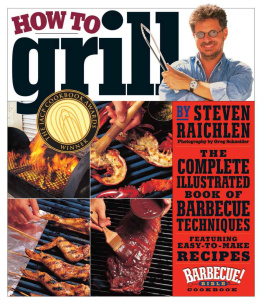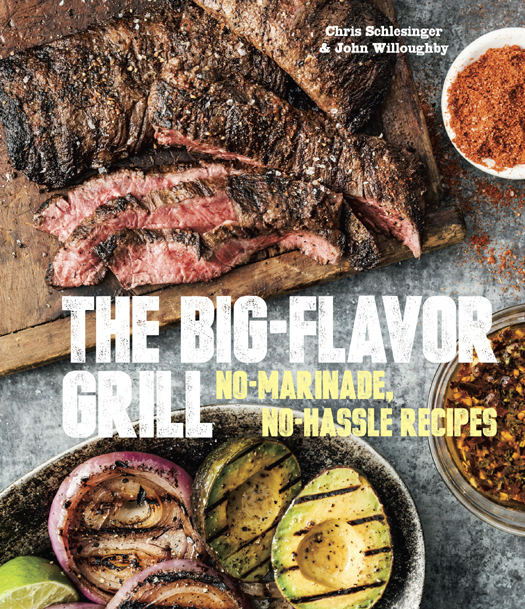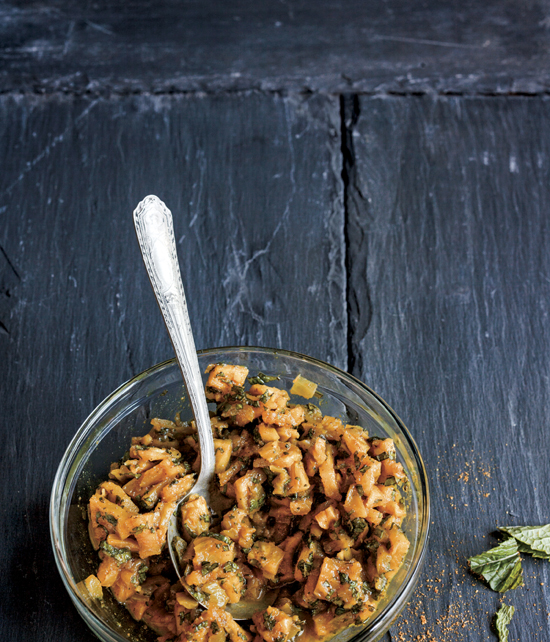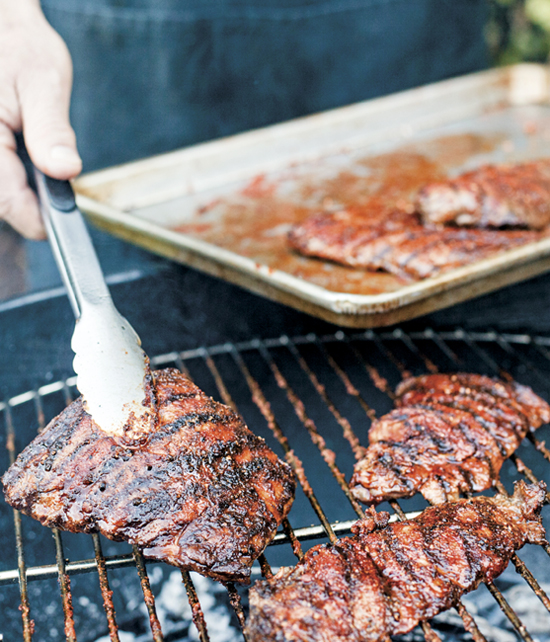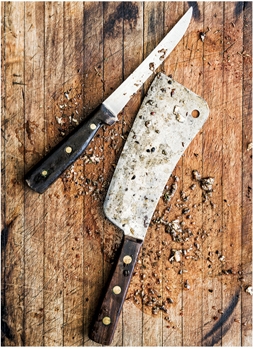Copyright 2014 by Chris Schlesinger and
John Willoughby
Photographs copyright 2014 by Ed Anderson
All rights reserved.
Published in the United States by Ten Speed Press,
an imprint of the Crown Publishing Group,
a division of Random House LLC,
a Penguin Random House Company, New York.
www.crownpublishing.com
www.tenspeed.com
Library of Congress Cataloging-in-Publication Data
Schlesinger, Chris, author.
The big-flavor grill / by Chris Schlesinger and John Willoughby ; photography by Ed Anderson. First edition.
pages cm
ISBN 978-1-60774-527-3 (hardback) ISBN 978-1-60774-528-0 (eBook) 1. Barbecuing. I. Willoughby, John, author. II. Title.
TX840.B3S2719 2014
641.76dc23
2013048751
Ten Speed Press and the Ten Speed Press colophon are registered trademarks of Random House LLC
Hardcover ISBN: 978-1-60774-527-3
eBook ISBN: 978-1-60774-528-0
Food stylist: George Dolese
Food styling assistant: Nan Bullock
Prop stylist: Ethel Brennan
v3.1
introduction
LATELY, IT SEEMS, cooking has become very complicated. Brine this. Marinate that. Make a sauce that takes three days. It seems like you have to take a week off to throw a dinner party.
We want to dial it back, to get out from under the yoke of complex formulations and intricate preparations. We want to take you back out to the grill, where cooking can be spontaneous and the food is easy but full of bold, intense flavors. One of the very best things about grilling is that it is a supremely simple process.
Or at least it should be simple. Because when you get down to it, all you really need is a fire, a grid, and a few bricks to hold up that grid. So when we go out to the grill, we want to cut through the scores of gadgets, the humongous gas burners, five different smokers, grapevine cuttings, all of the trappings that have been foisted onto grilling over the past couple of decades, and get back to easy creation of big flavors. Sorry, guys, about all your gadgets and secret sauces. We believe grilling is about proper technique and the flavors that are created through that technique. Fancy equipment and complicated strategies are just distractions.
In addition to being simple, grilling should be easy. So in the pages of this book, we hope to remind those of you who already know, and show those who dont, that big flavor does not need to be the result of big effort.
We learned this ourselves not from going to culinary school or practicing the techniques of classic Euro-style cooking, but from traveling in the tropics. If you want delicate, nuanced shadings of flavor in your food, then the labor-intensive creations of classic European cuisines are probably for you. But if youre looking for deep, explosive flavor without much work, then the hot-weather regions of the world are the placec to look.
Why? Because these two parts of the world have very different approaches to the process of developing flavor in a dish.
Much Euro-derived cooking employs what we like to call an architectural model, in which a range of individual flavors are combined to create a single new taste. To make a classic French sauce, for example, you first spend hours roasting bones and then cooking down water with those bones in it to create a base stock. Then you reduce this further with aromatics and maybe some meat. Then you reduce it further with herbs. Then when youre almost done, you slowly blend in a ton of butter. The result of all this is a kind of taste pyramid, with the top of the pyramid being a single, well-blended, subtle, intricate articulation of flavor.
But do you really want to do all this? Maybe once in a while, in the dead of winter when spending all day by the stove seems like a good idea.
But heres the other option: a Latin salsa. Chop up some perfectly ripe tomatoes, add some chiles and onions and a good dose of cumin, squeeze in a couple of limes, sprinkle in chopped cilantro, and youre good to go. What you get is a dish with what we call a geographical model, in which one flavor after anothersour, sweet, bitter, hot, aromatic, earthyis laid out for your taste buds in rapid succession. Rather than the long, smooth ride on a single flavor, you get the jolt and hum of many tastes. When properly done, each flavor complements and underscores the others, but they are all perfectly distinct.
To us, this geographical model is an equally valid approach to cooking. And to us, the big, bold, contrasting, competing but complementary flavors of hot-weather food are the more exciting option.
Its no coincidence that the standard method of cooking in hot climates, even to this day, is grilling over live fire. And grilling (assuming youre using charcoal or some variety of wood as your fuel) adds another element of smoky, seared flavor to anything you cook. So by its very nature, it mediates against any attempt to introduce subtlety or blended flavors.
In addition, this is also the part of the world where spices originated. This means that even everyday cooks in these regions are experts in spice use, and the intense flavors of these dried seeds, roots, barks, pods, and shoots are inextricably integrated into the cuisines.
Not coincidentally, grilling and spices are a very good combination. One of our favorite ways of using spices is to whip up a spice ruba mixture of spices based on one of scores of traditional combinations from around the wordthen coat the food with the rub before it goes over the fire. We long ago adopted spice rubs in place of marinades, the more traditional option for flavoring grilled foods. We did so because we found that spice rubs have all kinds of advantages over marinades. Since rubs consist almost solely of spices, at most moistened to a paste with a bit of oil, they provide stronger, better-defined flavors than marinades. They also stick better to the surface of foods, which again intensifies the flavor. Plus you can put them on at the last minute instead of having to think ahead, as you do with a marinadeand to us, not having to think ahead is definitely a major advantage.
But even with all their virtues, spice rubs arent the be-all and end-all of big-flavor cookery. If we used only them, wed miss the other flavors that you can get with marinades: the spark of citrus; the heavy, gentling sweetness of hoisin; the funk of fish sauce; the fresh licorice taste of basil; the familiar burn of fresh chiles. Since these ingredients dont really lend themselves to spice rubs, we began to think about how to bring them to our grilled dishesand came up with what we like to call razzle-dazzles.
This concept was actually developed down in Costa Rica. Along with a group of friends, we are part-owners of a little house on the water down there, and one of the primary activities is cooking. Everybody does a little somethingsomeone makes the salad, someone grills the entre, someone mixes the cocktails, someone figures out snacks for those predinner drinks. But the selection of ingredients down there can be limited. So we buy shrimp at the market when we can, or buy fish from a fisherman, or sometimes just go with the super-thin pork chops from the local bodega.




